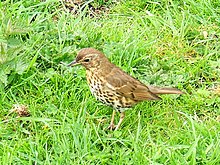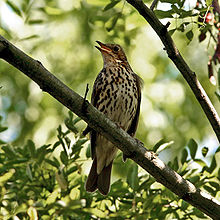歐歌鶇
| 歐歌鶇 | |
|---|---|

| |
| 科学分类 | |
| 界: | 动物界 Animalia |
| 门: | 脊索动物门 Chordata |
| 纲: | 鸟纲 Aves |
| 目: | 雀形目 Passeriformes |
| 科: | 鶇科 Turdidae |
| 属: | 鸫属 Turdus |
| 种: | 歐歌鶇 T. philomelos
|
| 二名法 | |
| Turdus philomelos Brehm, 1831
| |

| |
歐歌鶇(學名:Turdus philomelos)是一種分佈在歐亞大陸的鶇屬鳥類,上身呈褪色,下身呈奶白色或淺黃色,有黑色斑點。牠們歌聲獨特,常見於詩歌。
歐歌鶇在森林、花園和公園繁殖。牠們會在樹上以泥築巢,每次會生4-5顆蛋。牠們是雜食性的,懂得利用石頭作為鐵砧攻擊蝸牛。牠們就像其他雀形目般受體內、外的寄生蟲侵襲,且易被貓和猛禽捕食。
有一部份的歐歌鶇是候鳥,會飛到南歐、北非及中東過冬。牠們也有被引進到新西蘭及澳洲。牠們雖然並非瀕危,但在歐洲部份地區的數量大幅減少,可能是與種植業的改變有關。
科學分類
[编辑]命名
[编辑]歐歌鶇見於德國鳥類學家Christian Ludwig Brehm1831年的記載,其原學名一直沿用至今。[2]種小名是以希臘神話中的公主菲洛墨拉來命名,菲洛墨拉的舌頭被割下但卻變成了一隻會唱歌的鳥。[3]
分類
[编辑]分子研究顯示歐歌鶇是槲鶇及寶興歌鶇的近親。這三種是鶇屬早期的分支,分支出來的時間比牠們多樣化及擴散全球還要早,故與烏鶇較為疏遠。[4]

歐歌鶇其下有三個亞種:
- 指名亞種(T. p. philomelos):佔了大部份的分佈地;
- T. p. hebridensis:由英國鳥類學家William Eagle Clarke於1913年描述。牠們是一種留鳥,分佈在蘇格蘭的埃利安錫爾及斯凱島。牠們的顏色最為深色,背部呈深褐色,臀部灰色,上身淡淺黃色,兩側呈灰色。[5]
- T. p. clarkei:是由德國動物學家Ernst Hartert於1909年描述。牠們分佈在英國及愛爾蘭,並在法國、比利時及荷蘭,有可能也在更東的地區。牠們上身呈褐色,色澤較暖,臀部呈橄欖色,下身呈黃色。牠們是部份候鳥,一些會到法國南部及伊比利半島過冬。牠們可以與在中歐的指名亞種及在內赫布里底群島的T. p. hebridensis混種。[5]
另一個亞種,如西伯利亞的T. p. nataliae並未廣泛獲得接受。[5]
特徵
[编辑]
歐歌鶇長20-23.5厘米及重50-107克。兩性相似,背部呈褐色,下身呈奶白色或淺黃色,有黑色的斑點。翼底及喙呈黃色,腳是粉紅色的。牠們上身的顏色由瑞典至西伯利亞逐漸變冷色系。雛鳥像成鳥,但背上及翼底有淺黃色或橙色的斑紋。[5]
最像歐歌鶇的物種是白眉歌鶇,但牠們的眉是白色,兩側紅色。槲鶇較大,尾巴呈白色;寶興歌鶇雖然羽毛相似,但面上有黑色斑紋,而且分佈地也不重疊。[5]
歐歌鶇的叫聲短而尖銳,遷徙時會發出薄而高音的叫聲。警報聲會隨著危險而變得短及刺耳。雄鳥在樹上、天台或其他高位的叫聲是清晰的歌聲。在埃利安錫爾的群落一般會在2月至6月間發出這種叫聲,而其他亞種則要到11月至7月才發出這種叫聲。[5]牠們是叫聲最大的鳥類之一。[6]
雄鳥的歌聲可以多達100種劇目[7],大部份都是由父母處及鄰近的鳥類抄來。模仿聲包括人造的電話聲[8],牠們也會重覆飼養鳥類的叫聲,如白臉樹鴨。[5]
分佈及棲息地
[编辑]
歐歌鶇在大部份歐洲地區(但不包括大部份伊比利半島、義大利低地或希臘南部)、經烏克蘭及俄羅斯至貝加爾湖繁殖。牠們在挪威分佈至北緯75°,但在西伯利亞卻只達北緯60°。從斯堪地那維亞、東歐及俄羅斯而來的歐歌鶇會到地中海、北非及中東過冬,但在西部的只有一些會離開自己的地方。[5]
指名亞種於1860年及1880年由馴化協會引入到新西蘭及澳洲。[9]歐歌鶇在新西蘭快速適應及擴展至周邊的島嶼,如克馬德克群島、查塔姆群島及奧克蘭群島。[10]不過牠們在澳洲只限於在墨爾本附近的地方。[11]歐歌鶇在新西蘭掠食無脊椎動物造成一定影響[12],而牠們也對果園造成商業損失。[13]歐歌鶇在新西蘭作為入侵物種,故沒有法律保障。[14]
歐歌鶇一般棲息在有草叢及鄰近開放地方的森林,而在西歐則也會棲息在花園及公園。牠們可以在林木線繁殖,在瑞士就可達2200米。T. p. hebridensis會在較為開放的郊野繁殖,包括荒原;而在東部的指名亞種則只限於茂密的針葉林內繁殖。[5]英國一項研究發現歐歌鶇的分佈地只有3.5%是農地,而花園則佔了71.5%。餘下的則是林地。[15]牠們過冬的地方與繁殖地相近,但不會在高原及其他開放的地方。[16]不過T. p. hebridensis會經常走到海岸過冬。[5]
行為
[编辑]歐歌鶇並不經常聚居,有時在冬天或環境適合覓食時才會走在一起,也有可能與烏鶇、田鶇或白眉歌鶇一起生活。[5]牠們傾向回到同一過冬的地區。[16]
歐歌鶇是一夫一妻制的。在會遷徙的地區,雄鳥回到繁殖地後會重新設立地盤及開始唱歌;而在其他地區,雄鳥會全年留在自己的地盤,間中唱歌,但雌鳥可能會自行設立過冬的地點,直至於初春時配對在一起。[16]
在遷徙時,歐歌鶇主要在夜間展開旅程,並採取直接及強烈的飛行行動。牠們會以鬆散的小群橫渡海洋,並經常互相呼叫保持聯繫。[5]在較北部的歐歌鶇會於4月至8月進行遷徙,而大部份的因路程較短,則會在9月至12月中旬才南下。惡劣的氣候可以使牠們遷徙得更遠。回程的時間各有不同,如在地中海的是約在2月中旬,而瑞典北部及西伯利亞中部的則會在5月。[5]在格陵蘭、多個大西洋島嶼及西非曾發現一些離群的份子。[5]
繁殖及生存
[编辑]
雌性歐歌鶇會在灌木、樹或蔓上築巢,T. p. hebridensis則會在地上築巢。牠們會以泥及乾草築巢。雌鳥每次會生4-5顆蛋,鳥蛋呈鮮藍色,有些少黑色或紫色的斑點[5],蛋約有2.7 x 2.0厘米大小及重6克,當中6%為蛋殼。[3]雌鳥會獨自孵蛋10-17日;孵化後10-17日雛鳥就會換羽。牠們每年一般生2-3次蛋,但在北部地區的可能只有一隻雛鳥能仍長。[5]平均而言,54.6%的英國雛鳥於首年仍然生存,成年的每年生存率為62.2%。牠們的壽命為3年,但最老的可以老達10歲8個月。[3]

歐歌鶇有時會成為大杜鵑等的寄主,但此情況很罕有,因牠們能夠發現杜鵑鳥蛋的不同。[17]不過,牠們不會帶有與烏鶇相同的攻擊性對付成年杜鵑。[18]在新西蘭入侵的歐歌鶇在以往超過130年間都能分辨非偽裝的鳥蛋。[19]
貓、縱紋腹小鴞及雀鷹等會掠食成年歐歌鶇;喜鵲、松鴉及灰松鼠也會掠食鳥蛋及雛鳥。[20][21][22]就像其他的雀形目,歐歌鶇也有寄生蟲,如線蟲動物門的Splendidofilaria (Avifilaria) mavis。[23]一項俄羅斯有關血液寄生蟲的研究顯示所有田鶇、白眉歌鶇及歐歌鶇含有變形血原蟲屬及錐蟲屬。[24]硬蜱屬也很普遍,牠們也會帶有病原體,包括在俄羅斯、東歐及中歐森林地區的腦炎[25],與及較為普遍的疏螺旋體屬。[26]一些疏螺旋體屬的物種會引起萊姆病,而歐歌鶇等在地上覓食的雀鳥則是此病的溫床。[27]
覓食
[编辑]
歐歌鶇是雜食性的,吃多種無脊椎動物,尤其是蚯蚓及蝸牛,也會吃軟果實及草莓。牠們會以視覺來尋找獵物,或會在葉堆中尋找潛在食物。[5]
當在乾旱或惡劣的環境下,蝸牛是歐歌鶇重要的食物。牠們會用石頭來敲碎蝸牛的殼,抽出軟體部份,並將之放在地上擦。[16]幼鳥最初會學習拋物件,直至懂得使用工具來敲碎蝸牛殼。[28]雛鳥主要吃動物食物,如蠕蟲、蛞蝓、蝸牛及昆蟲幼蟲。[5]
二樹叢蝸牛經常被歐歌鶇所掠食,它們多態的殼被認為是為了減低掠食而進化的。[29]不過,歐歌鶇並非唯一的掠食者。[30]
保育狀況
[编辑]歐歌鶇的分佈地很廣,估計達1000萬平方公里,單在歐洲的數量就估計有4000-7100萬隻。[1]
在古北界西部,有證據顯示數量下降,但並未達至保育的水平,故世界自然保護聯盟將之列為無危。[1]在英國及荷蘭,牠們的數量就下降了50%。[16][31]在農地上的數量下降得最厲害,相信是與種植業的改變有關。[32]真實原因但卻不明,也有可能與樹籬的消失或加劇使用殺蟲劑有關。這種改變令食物的供應減少。[33]在花園,使用毒餌來控制蛞蝓及蝸牛也對歐歌鶇造成危害。[22]在城市,牠們也成為了路殺。[34]
文化
[编辑]托馬斯·哈代[35]、泰德·休斯[36]及威廉·華茲華斯[37]也在其詩中描述了歐歌鶇。
食物
[编辑]歐歌鶇最早於12000年前被捕獵作為食物[38],在《奧德賽》也有記載。[39]在地中海一直至今也有捕獵牠們,但並非牠們在某些地區真正減少的原因。[32]
在西班牙仍然有用粘鳥膠來捕捉歐歌鶇。[40]於2003年及2004年,歐盟嘗試禁止這種捕獵方法,但不成功。[41][42]
寵物
[编辑]歐歌鶇最少於19世紀就已經被捕捉作為寵物。[43]同樣地也沒有證據顯示捕捉牠們作為寵物令其數量下降。[5]
參考
[编辑]- ^ 1.0 1.1 1.2 BirdLife International. Turdus philomelos. The IUCN Red List of Threatened Species 2004. [2006-05-12].
- ^ (德文)Brehm, Christian. Handbuch der Naturgeschichte aller Vogel Deutschlands. 1831: 382.
- ^ 3.0 3.1 3.2 Song Thrush Turdus philomelos [CL Brehm, 1831]. BTO Birdfacts. British Trust for Ornithology. [2008-01-25]. (原始内容存档于2013-04-01).
- ^ Voelker G, Rohwer S, Bowie RCK, Outlaw DC. Molecular systematics of a speciose, cosmopolitan songbird genus: Defining the limits of, and relationships among, the Turdus thrushes. Molecular Phylogenetics and Evolution. 2007, 42 (2): 422–34. PMID 16971142. doi:10.1016/j.ympev.2006.07.016.
- ^ 5.00 5.01 5.02 5.03 5.04 5.05 5.06 5.07 5.08 5.09 5.10 5.11 5.12 5.13 5.14 5.15 5.16 5.17 5.18 Clement, Peter; Hathway, Ren; Wilczur, Jan. Thrushes (Helm Identification Guides). Christopher Helm Publishers Ltd. 2000: 392–5. ISBN 0-7136-3940-7.
- ^ Brackenbury, J. H. Power capabilities of the avian sound-producing system (PDF). J. Exp. Biology. 1979, 78: 163–6 [2010-07-02]. (原始内容存档 (PDF)于2008-10-10).
- ^ Devoogd, Timothy J.; John R. Krebs, Susan D. Healy, Andy Purvis. Relations between Song Repertoire Size and the Volume of Brain Nuclei Related to Song: Comparative Evolutionary Analyses amongst Oscine Birds.. Proceedings: Biological Sciences. 1993, 254 (1340): 75–82. doi:10.1098/rspb.1993.0129.
- ^ Slater, Peter J. B. The Buzby phenomenon: Thrushes and telephones. Animal Behavior. 1983, 31: 308–309. doi:10.1016/S0003-3472(83)80204-8.
- ^ 'BIRDS', from An Encyclopaedia of New Zealand, edited by A. H. McLintock, originally published in 1966. Te Ara - The Encyclopedia of New Zealand, updated 18-Sep-2007. Ministry for Culture and Heritage / Te Manatū Taonga. [2008-03-13]. (原始内容存档于2008-09-07).
- ^ Heather, B.; Robertson, H. The Field Guide to the Birds of New Zealand. Auckland: Viking. 1996: 384–5. ISBN 0-670-89370-6.
- ^ Song thrush (Turdus philomelos). Birds. Department of Agriculture, Western Australia. [2008-01-25]. (原始内容存档于2007-12-08).
- ^ The State of Our Invertebrate Animals. State of New Zealand's Environment 1997, Chapter 9. Ministry for the Environment, New Zealand. [2008-03-13]. (原始内容存档于2008-06-17).
- ^ Song thrush (Turdus philomelos). Department of Agriculture and Food Western Australia. [2008-03-13]. (原始内容存档于2007-12-08).
- ^ The State of Our Indigenous Birds (PDF). The State of Our Biodiversity - The State of New Zealand’s Environment. Ministry for the Environment, New Zealand. [2008-03-13]. (原始内容 (PDF)存档于2015-01-24).
- ^ Mason, Christopher F. Habitats of the Song Thrush Turdus philomelos in a largely arable landscape. Journal of Zoology. 1998, 244: 89–93. doi:10.1111/j.1469-7998.1998.tb00010.x.
- ^ 16.0 16.1 16.2 16.3 16.4 Snow, David; Perrins, Christopher M (editors). The Birds of the Western Palearctic concise edition (2 volumes). Oxford: Oxford University Press. 1998: 1225–8. ISBN 0-19-854099-X.
- ^ Davies, N. B. Cuckoo tricks with eggs and chicks. British Birds. March 2002, 95 (3): 101–15.
- ^ Grim, Tomáŝ; Honza, Marcel. Differences in behaviour of closely related thrushes (Turdus philomelos and T. merula) to experimental parasitism by the common cuckoo Cuculus canorus (PDF). Biologia, Bratislava. 2001, 56 (5): 549–56 [2018-09-13]. (原始内容 (PDF)存档于2017-08-09).
- ^ Hale, Katrina & Briskie, James V. Response of introduced European birds in New Zealand to experimental brood parasitism. Journal of Avian Biology. 2007-11-06, 38 (2): 198–204 [2010-07-02]. doi:10.1111/j.2007.0908-8857.03734.x. (原始内容存档于2022-10-17) (英语).
- ^ Brown, Roy. A Review of the impact of Mammalian Predators on Farm Songbird Population Dynamics (PDF). Songbird Survival. [2008-01-27]. (原始内容 (PDF)存档于2007-07-02).
- ^ Song thrush. Birds and wildlife. RSPB. [2008-01-27]. (原始内容存档于2009-04-26).
- ^ 22.0 22.1 Song thrush - Turdus philomelos. Gardening with Wildlife in Mind. Natural England. [2008-01-28]. (原始内容存档于2009-08-15).
- ^ (西班牙文)Martil, S. Cano; Caballero, E.J. López; del Valle Portilla, María T. Estudio con microscopia electrónica de barrido de adultos de Splendidofilaria (Avifilaria) Mavis (Leiper, 1909) Anderson, 1961. (PDF). Revista biologia. 2000, 14 (1). (原始内容 (PDF)存档于2009-03-18).
- ^ Palinauskas, Vaidas; Markovets, Mikhail Yu; Kosarev, Vladislav V; Efremov, Vladislav D; Sokolov Leonid V; Valkiûnas, Gediminas. Occurrence of avian haematozoa in Ekaterinburg and Irkutsk districts of Russia (PDF). Ekologija. 2005, 4: 8–12. (原始内容 (PDF)存档于2009-03-26).
- ^ Fedorov, Yu. V. (1968) "Further observations on the significance of wild birds as hosts of Ixodes ticks in the Tomsk focus of tick-borne encephalitis" 互联网档案馆的存檔,存档日期2009-02-25. Pentagon Reports Number: 0916176 (PDF)
- ^ Kipp, Susanne; Goedecke, Andreas; Dorn, Wolfram; Wilske, Bettina; VolkeFingerle. Role of birds in Thuringia, Germany, in the natural cycle of Borrelia burgdorferi sensu lato, the Lyme disease spirochaete. International Journal of Medical Microbiology. May 2006, 296: 125–8. PMID 16530003. doi:10.1016/j.ijmm.2006.01.001.
- ^ Comstedt, Pär; Bergström, Sven: Olsen, Björn; Garpmo, Ulf; Marjavaara, Lisette; Mejlon, Hans; Barbour, Alan G. and Bunikis, Jonas. Migratory Passerine Birds as Reservoirs of Lyme Borreliosis in Europe (PDF). Emerging Infectious Diseases. July 2006, 12 (7): 1087–94 [2010-07-02]. (原始内容 (PDF)存档于2010-10-11).
- ^ Henty, C. J. Development of snail-smashing by song thrushes. British Birds. 1986, 79: 277–81.
- ^ Goodhart, C. B. Thrush Predation on the Snail Cepaea hortensis. The Journal of Animal Ecology. May 1958, 27 (1): 47–57. doi:10.2307/2173.
- ^ Owen, Denis F.; Sven-Axel Bengtson. Polymorphism in the Land Snail Cepaea Hortensis in Iceland.. Oikos. 1972, 23 (2): 218–25. doi:10.2307/3543409.
- ^ Song Thrush Turdus philomelos. Breeding Birds in the Wider Countryside. British Trust for Ornithology/Joint Nature Conservation Committee. [2008-01-27]. (原始内容存档于2008-06-17).
- ^ 32.0 32.1 Cocker, Mark; Mabey, Richard. Birds Britannica. London: Chatto & Windus. 2005: 355–9. ISBN 0-7011-6907-9.
- ^ Song Thrush (Turdus philomelos). Species Action Plan. UK Biodiversity Action Plan. [2008-03-11]. (原始内容存档于2008-04-15).
- ^ Erritzoe, J.; Mazgajski T. D., Rejt L. Bird casualties on European roads — a review. (PDF). Acta Ornithol. 2003, 38: 77–93 [2010-07-02]. (原始内容存档 (PDF)于2017-08-09).
- ^ Stallings, A. E. The Darkling Thrush: A Centennial Appreciation. [2008-03-11]. (原始内容存档于2008-05-19).
- ^ Thrushes. Poems by Ted Hughes. Poemhunter. [2008-03-11]. (原始内容存档于2019-05-22).
- ^ The Tables Turned. William Wordsworth: Complete Poetical Works. bartleby.com. [2008-01-29]. (原始内容存档于2008-02-03).
- ^ Bocheñski, Z.; Tomek T. Bird remains from a rock-shelter in Krucza Skala (Central Poland) (PDF). Acta zooologica cracoviensia. 2004, 47 (1-2): 27–47 [2010-07-02]. (原始内容 (PDF)存档于2020-07-27).
- ^ Homer; Fagles, Robert (translator). The Odyssey. New York: Penguin Books. 1997: 453. ISBN 0-14-026886-3.
- ^ Commission of the European Communities. Failure of a Member State to fulfil obligations – Directive 79/409/EEC – Conservation of wild birds – Hunting using limed twigs - Summary of the Judgment. 9 December 2004 [2010-07-02]. (原始内容存档于2019-05-26).
- ^ (西班牙文)Las Provincias. Un entramado para cazar tordos. 14 December 2006 [2010-07-02]. (原始内容存档于2016-03-03).
- ^ (西班牙文)Europa Press. El Tribunal de la UE condena a España por permitir la caza con 'parany' en la Comunidad Valenciana. (原始内容存档于2008-06-14).
- ^ Dyson, C. E. Bird-Keeping - A Practical Guide for the Management of Singing and Cage Birds. Frederick Warne and co. 1889: 51.
外部連結
[编辑]- RSPB (页面存档备份,存于互联网档案馆)
- BBC Archive.is的存檔,存档日期2012-12-23
- Birds of Britain (页面存档备份,存于互联网档案馆)
- Garden Birds (页面存档备份,存于互联网档案馆)
- Internet Bird Collection (页面存档备份,存于互联网档案馆)


